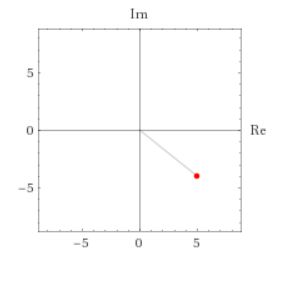
the two parts of the complex number are graphed on different axes.
#5# is the real part of the number, while #-4i# is the imaginary part.
#5# is graphed as #5# to the right, on the real axis.
#-4i# is graphed as #4# down, on the imaginary axis.
the modulus is the point's distance from #0#. (in the picture, the distance is shown by a thin grey line)
the value of the modulus (i.e. the length of the line) can be calculated using Pythagoras' theorem, where the modulus is the hypotenuse.
#a^2 + b^2 = c^2#
#a# and #b# are the distances from the real and imaginary axes. here, these are #5# and #4#.
#5^2 + 4^2 = c^2#
#c^2 = 25 + 16 = 41#
#c = sqrt41#
this means that the length of the line, and therefore the value of the modulus, is #sqrt41# as an exact value.
rounded, it is #6.4# to the nearest tenth.

